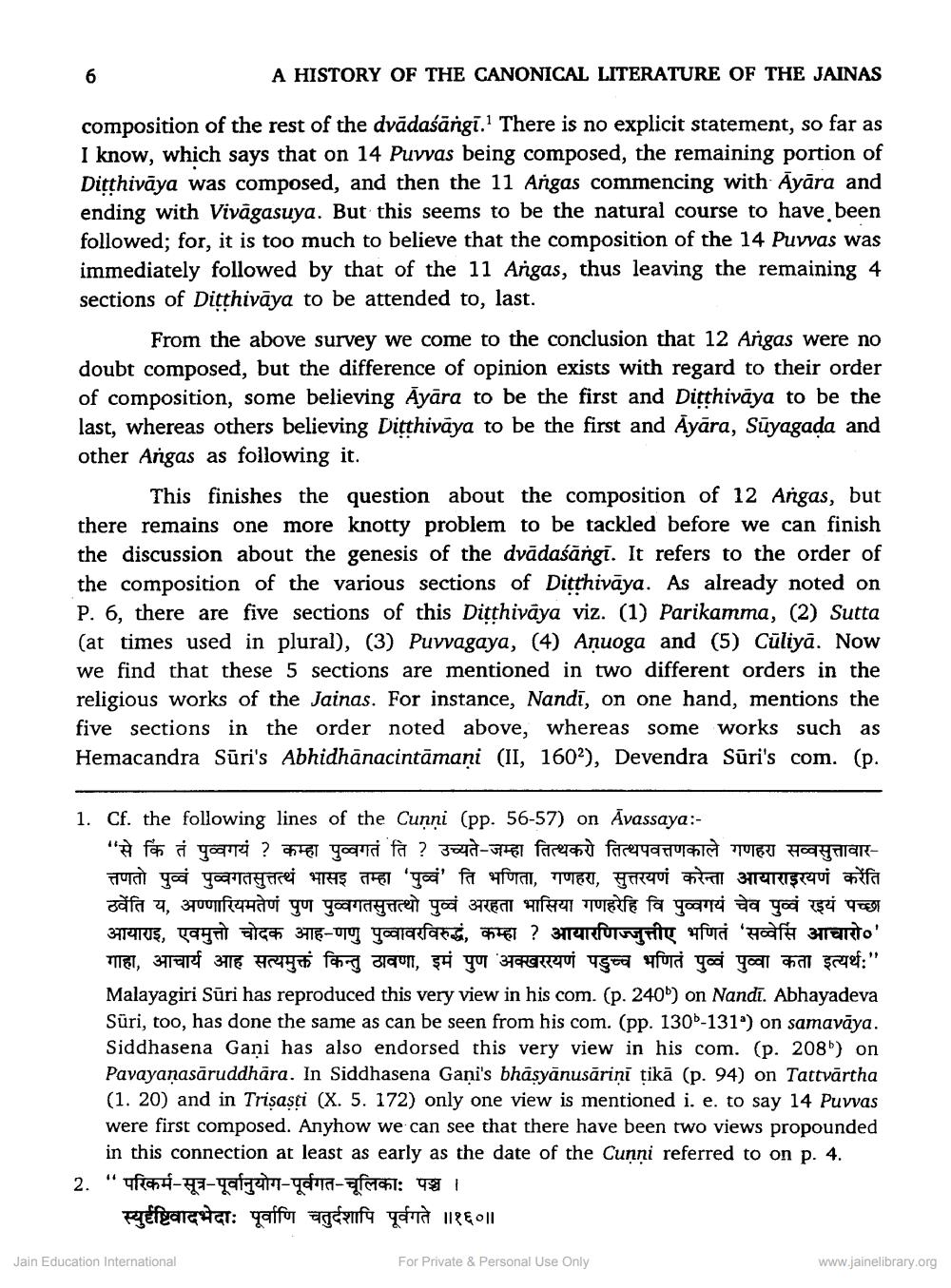________________
A HISTORY OF THE CANONICAL LITERATURE OF THE JAINAS
composition of the rest of the dvādaśangi. There is no explicit statement, so far as I know, which says that on 14 Puvvas being composed, the remaining portion of Ditthivāya was composed, and then the 11 Angas commencing with Ayāra and ending with Vivāgasuya. But this seems to be the natural course to have been followed; for, it is too much to believe that the composition of the 14 Puvvas was immediately followed by that of the 11 Angas, thus leaving the remaining 4 sections of Ditthivāya to be attended to, last.
From the above survey we come to the conclusion that 12 Angas were no doubt composed, but the difference of opinion exists with regard to their order of composition, some believing Āyāra to be the first and Ditthivaya to be the last, whereas others believing Ditthivaya to be the first and Āyara, Sūyagada and other Angas as following it.
This finishes the question about the composition of 12 Angas, but there remains one more knotty problem to be tackled before we can finish the discussion about the genesis of the dvādaśārgi. It refers to the order of the composition of the various sections of Ditthivāya. As already noted on P. 6, there are five sections of this Ditthivāya viz. (1) Parikamma, (2) Sutta (at times used in plural), (3) Puvvagaya, (4) Anuoga and (5) Cūliyā. Now we find that these 5 sections are mentioned in two different orders in the religious works of the Jainas. For instance, Nandi, on one hand, mentions the five sections in the order noted above, whereas some works such as Hemacandra Sūri's Abhidhānacintāmani (II, 1602), Devendra Sūri's com. (p.
1. Cf. the following lines of the Cunni (pp. 56-57) on Avassaya:
"से कि तं पुव्वगयं ? कम्हा पुव्वगतं ति ? उच्यते-जम्हा तित्थकरो तित्थपवत्तणकाले गणहरा सव्वसुत्तावारत्तणतो पुव्वं पुव्वगतसुत्तत्थं भासइ तम्हा 'पुव्वं' ति भणिता, गणहरा, सुत्तरयणं करेन्ता आयाराइरयणं करेंति ठवेंति य, अण्णारियमतेणं पुण पुव्वगतसुत्तत्थो पुव्वं अरहता भासिया गणहरेहि वि पुव्वगयं चेव पुव्वं रइयं पच्छा आयाराइ, एवमुत्तो चोदक आह-णणु पुव्वावरविरुद्धं, कम्हा ? आयारणिज्जुत्तीए भणितं 'सव्वेर्सि आचारो०' गाहा, आचार्य आह सत्यमुक्तं किन्तु ठावणा, इमं पुण अक्खररयणं पडुच्च भणितं पुव्वं पुव्वा कता इत्यर्थ:" Malayagiri Sūri has reproduced this very view in his com. (p. 2406) on Nandi. Abhayadeva Sūri, too, has done the same as can be seen from his com. (pp. 1306-131") on samavāya. Siddhasena Gani has also endorsed this very view in his com. (p. 208") on Pavayaņasāruddhāra. In Siddhasena Gani's bhāsyānusāriņi tikā (p. 94) on Tattvārtha (1. 20) and in Trisasti (X. 5. 172) only one view is mentioned i. e. to say 14 Puvvas were first composed. Anyhow we can see that there have been two views propounded
in this connection at least as early as the date of the Cunni referred to on p. 4. 2. "uficha-qarqenye ma-ach: 41
स्युष्टिवादभेदाः पूर्वाणि चतुर्दशापि पूर्वगते ॥१६०॥
Jain Education International
For Private & Personal Use Only
www.jainelibrary.org




